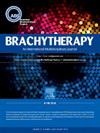Primary vaginal cancer treated with high-dose rate brachytherapy and intraprocedural magnetic resonance imaging
IF 1.7
4区 医学
Q4 ONCOLOGY
引用次数: 0
Abstract
PURPOSE
To report outcomes among primary vaginal cancer patients treated definitively with either external beam radiation therapy plus high-dose rate (HDR) brachytherapy (EBRT-BT) or BT (BT) alone with placement of interstitial catheters under magnetic resonance imaging (MRI) guidance.
METHODS
Retrospective review of 41 patients treated for primary vaginal cancer from 2016 to 2022. Kaplan-Meier (KM) estimates were generated for disease-free survival (DFS), local control (LC), and overall survival (OS).
RESULTS
Median follow-up was 28 months (range 2–82 months). A total of 36 patients had EBRT-BT, 5 had BT alone. Forty patients had template interstitial and 1 had a multichannel cylinder. Among patients who received EBRT-BT, median total D90 EQD2 was 68.3 Gray (Gy) (range 56.6–91.5 Gy); BT only, median 40.3 Gy (range 38.1–86.3 Gy). No patient experienced local only failure. Relapse occurred in 12 patients treated with EBRT-BT versus 1 with BT alone group. For the EBRT-BT cohort versus BT only cohort, 2-year OS was 81% versus 60%, DFS 61% versus 40%, and LC was 94% versus 80%, respectively. For the entire cohort, 2-year OS was 67%, and median OS was 5 years. The 2-year DFS was 57% and 2-year LC was 93%. The most common any grade acute treatment-related toxicity were grade 1 vaginal pain and stenosis. Grade 3 acute and late toxicities were minimal.
CONCLUSIONS
MRI-guided HDR BT for primary vaginal cancer yields high rates of local control with limited toxicities. Lower rates of distant control indicate the need for newer options such as immunotherapy or other systemic agents.
高剂量率近距离放疗和术中磁共振成像治疗原发性阴道癌。
目的:报告原发性阴道癌患者在核磁共振成像(MRI)指导下明确接受外束放射治疗加高剂量率(HDR)近距离治疗(EBRT-BT)或单独接受间质导管植入的BT (BT)治疗的结果。方法:回顾性分析2016 ~ 2022年收治的41例原发性阴道癌患者的临床资料。对无病生存期(DFS)、局部控制期(LC)和总生存期(OS)进行Kaplan-Meier (KM)估计。结果:中位随访时间为28个月(2-82个月)。EBRT-BT患者36例,单独BT患者5例。40例有模板间质,1例有多道圆柱。在接受EBRT-BT的患者中,中位总D90 EQD2为68.3 Gy(范围56.6-91.5 Gy);仅BT,中位数40.3 Gy(范围38.1-86.3 Gy)。没有患者出现局部失败。接受EBRT-BT治疗的患者中有12例复发,而单独接受BT治疗的患者中有1例复发。对于EBRT-BT队列和仅BT队列,2年OS分别为81%和60%,DFS为61%和40%,LC为94%和80%。对于整个队列,2年的生存期为67%,中位生存期为5年。2年DFS为57%,2年LC为93%。最常见的急性治疗相关毒性是1级阴道疼痛和狭窄。3级急性和晚期毒性最小。结论:mri引导下HDR BT治疗原发性阴道癌的局部控制率高,毒性有限。较低的远程控制率表明需要更新的选择,如免疫治疗或其他全身药物。
本文章由计算机程序翻译,如有差异,请以英文原文为准。
求助全文
约1分钟内获得全文
求助全文
来源期刊

Brachytherapy
医学-核医学
CiteScore
3.40
自引率
21.10%
发文量
119
审稿时长
9.1 weeks
期刊介绍:
Brachytherapy is an international and multidisciplinary journal that publishes original peer-reviewed articles and selected reviews on the techniques and clinical applications of interstitial and intracavitary radiation in the management of cancers. Laboratory and experimental research relevant to clinical practice is also included. Related disciplines include medical physics, medical oncology, and radiation oncology and radiology. Brachytherapy publishes technical advances, original articles, reviews, and point/counterpoint on controversial issues. Original articles that address any aspect of brachytherapy are invited. Letters to the Editor-in-Chief are encouraged.
 求助内容:
求助内容: 应助结果提醒方式:
应助结果提醒方式:


